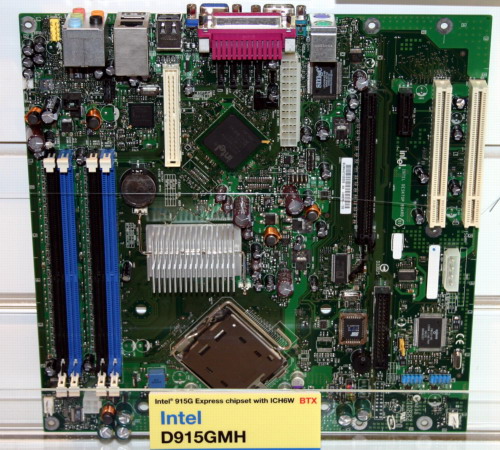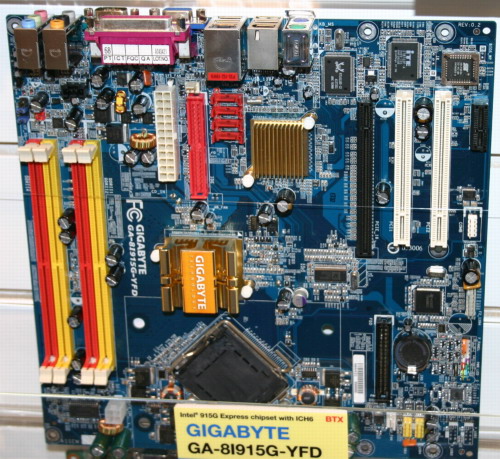
Original Link: https://www.anandtech.com/show/1340
Computex 2004: BTX at the Show
by Anand Lal Shimpi on June 2, 2004 7:17 AM EST- Posted in
- Trade Shows
It used to be that Computex was spread across three different halls in or around the Taipei World Trade Center. Recently however a fourth hall was added, thanks to Computex's growth among other factors. For those of you that are curious, the halls themselves are all within walking distance of one another, but the walk seems much longer thanks to Taipei's incredible humidity.
This year the weather seems to be much milder than normal, making the journey better than normal, but still a tiring one. The halls are thankfully better air conditioned this time around, so at least your arrival at the halls is more welcoming than not. The majority of our coverage has been from Hall 2, since that's where most of the motherboard guys are located. But there are still a few gems to be found in the other halls, as we found out today.

...but even more interesting exhibits were at Hall 4
When we first went around the show floor we were severely disappointed with the lack of BTX motherboards and platforms being presented. After complaining about it to Intel, we were directed to their technology showcase here at Computex. It was at Intel's showcase in Hall 4 where we found all of the missing BTX boards and systems we'd been looking for.
For those of you interested in BTX, this part of our coverage is definitely for you.
Be sure to also read our other Computex coverage:
Computex 2004 Early Bird Coverage: NV45 in the Flesh, New Chipsets, BTX boards and more...
Computex 2004: More NV45 Information
Computex 2004: NV45 Mystery Solved
Why everyone hates BTX
For the past several IDFs Intel has been pushing BTX (Balanced Technology eXtended) as the logical successor to ATX. Boasting a brand new layout along with new power supply specifications and new connector specifications, BTX is new, exciting and...experiencing quite a bit of backlash from the community.
Most critics of BTX seem to view it as a workaround to Intel's heat "problem" with their CPUs. More specifically, Prescott is a very hot CPU and is Intel's pushing of the BTX standard merely a way of making up for producing very hot microprocessors?
There's also the issue of heavy investments in ATX. Switching CPU sockets is one thing, but force people to buy all new cases, power supplies and motherboards and you're bound to get some negative response. Needless to say, since virtually everyone today is an ATX owner, the thought (and expense) of moving to BTX isn't exactly desirable.
Unlike most transitions we see in this industry, the move to BTX won't be an aggressive one. Granted you'll see newer systems shipping with BTX platforms, but as is very evident by the showing at Computex, the vast, vast majority of produced in the next year will continue to be ATX. As we've reported in our earlier coverage, there were only two BTX motherboards shown off at the show floor at Computex - not exactly signs of an overwhelming technology push. To Intel's credit, pushing for a brand new form factor is mostly like pulling teeth...underwater, with tweezers - it's not easy.
There are other complaints about BTX, one major one being that Intel seems to be the only one interested in pushing it, which further supports the conspiracy theory that it's just a way to deal with their extremely hot processors. One possible limitation is that BTX's layout isn't exactly very friendly to AMD's on-die memory controller; look at the picture below of a BTX motherboard and note the difficulty in running equal length traces from the CPU to the memory banks. It's not impossible and there are companies that have developed methods around trace length matching that could come in handy here, but needless to say that no AMD motherboard manufacturer is too eager to design an Athlon 64 BTX motherboard at this point. It will most likely require AMD's engineering intervention to develop a properly laid out BTX motherboard for Athlon 64 before we start seeing platforms, and with Intel driving the standard it is highly unlikely that AMD is going to be a champion of it this early in the game. After all, although AMD can benefit from a cooler running platform, they are in much less need of it than Intel at this point; plus, why not make Intel's job as hard as possible? It's only fair.
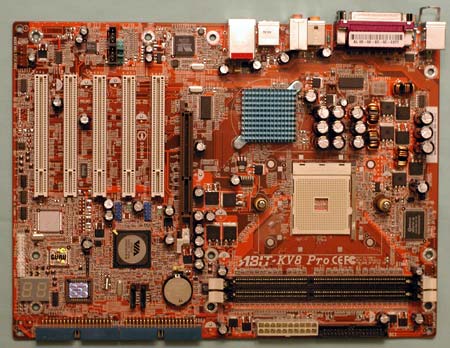
Note the direct path from the CPU to the memory banks on this Athlon 64 motherboard
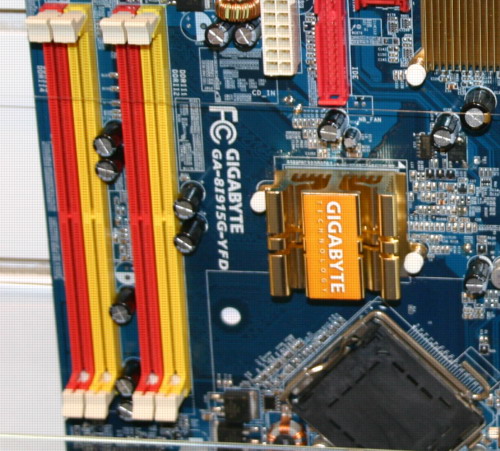
BTX requires the CPU to be at the "front" of the motherboard, with the chipset behind it. Without moving the CPU to the middle of the motherboard, BTX provides some interesting challenges for AMD's on-die memory controller. A direct, equal length path to the memory banks is much easier to implement than this sort of a layout.
With all of the negativity and complaints aside, like it or not, BTX is coming and it will bring a lot of positives with it. Smaller form factors (although not as small as the ones championed by Shuttle), cooler internals and quieter overall systems are all benefits that cannot be ignored. Intel has put in a significant amount of engineering work into designing BTX and we do believe that it has the potential to deliver on its promises once designs hit the market. But the real question is when? We just mentioned that the transition will be a slow one, but in order to ease the fears of the market Intel managed to round up a bunch of BTX motherboards and display them at their showcase here at Computex. What's interesting is that these boards weren't shown off at the individual manufacturer's booths for the most part, indicating that they are not exactly top priority for these manufacturers. That being said, the board designs were available for us (read: our camera) and thus we bring you some of the very first BTX motherboards from ASUS, Gigabyte, MSI and more...
BTX Motherboards Galore
You'll remember from our BTX article that there are three flavors of BTX: pico, micro and regular BTX. Most of the motherboards we saw were micro BTX, meaning they had four expansion slots and are about the size of a micro ATX motherboard.
Of course, Intel's micro BTX motherboard was present at the Intel showcase:
The Intel board features the newly announced 915 chipset, and features two PCI Express slots and two 32-bit PCI slots. One of the more noticeable changes BTX offers is that the graphics card slot (PCI Express x16) is now the last slot (or the first depending on how you look at it) on the board, making cooling much easier and much less restrictive.
It may be difficult to see in this picture, but note that the four SATA ports are located directly behind the parallel port at the top of the picture. It's sort of ironic to put one of the latest interface standards directly behind one of the oldest and most cumbersome.
It was good to see boards from companies like Gigabyte present as well, after all what use is an industry standard if Intel is the only one to demonstrate it?
Gigabyte's board is also a micro BTX, indicated by its four expansion slots. Gigabyte's slot layout is a bit different from Intel's, as are their SATA and BTX power connectors. Considering where the SATA cables will end up, Intel's orientation of the connectors may make more sense and require less twisting of the already fragile SATA connectors to install properly.
MSI's board was also a departure from Intel's design, and we believe it also violates the BTX spec (or at least one of its goals). Can you see the problem?
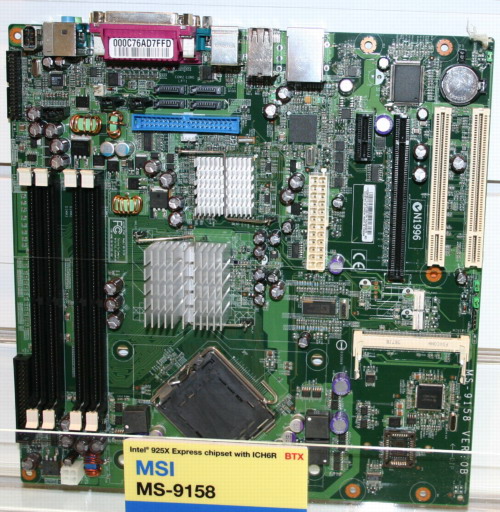
Look carefully at the expansion slots, the PCI Express x16 slot isn't the first slot on the board, there's an x1 slot that comes before it - defeating one of the cooling purposes of BTX. To MSI's credit, this is most likely a very early motherboard sample without much care or attention paid to such details, but this could also be one reason why more BTX motherboards haven't been shown off - a lack of spec compliance.
MSI's solution was 925X based, which is the first 925X based BTX motherboard that we've seen thus far.
BTX Motherboards from ASUS and MiTAC
ASUS seemed to do a good job of meeting BTX spec with their P5G6B design:
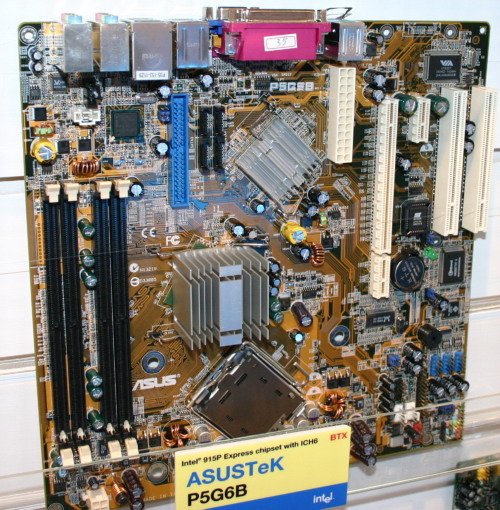
Unfortunately the presence of the ATX power connector that close to the PCI Express x16 slot also does not do a good job of making room for large coolers on PCI Express graphics cards. Granted it is a bit of a puzzle as to how two-slot PCI Express graphics cards would fit in micro BTX systems like this one; there doesn't seem to be enough room to the left of the x16 slot to fit another slot cutout.
MiTAC (owners of Tyan) had a board almost identical to Intel's solution, also based on the 915 chipset:
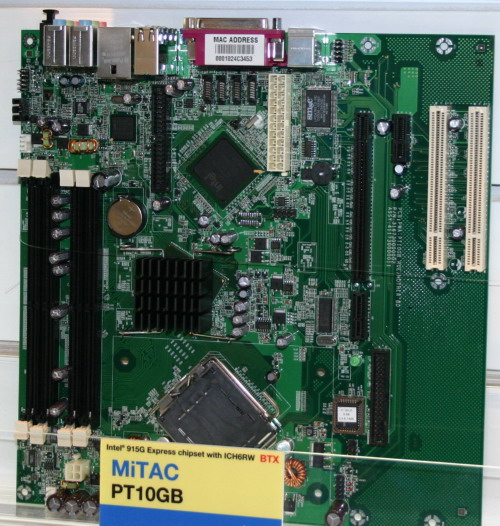
Much like the ASUS board, MiTAC's PT10GB has a small connector at the end of the PCI Express x16 slot. That particular connector is another x1 connector, which we are hypothesizing is used to deliver extra power to extremely power hungry graphics cards.
Chenbro's BTX Tower
While all of the motherboards at Intel's showcase were microBTX and the two boards on the show floor were picoBTX, Chenbro had a full BTX tower on display:

From the outside the BTX case looks no different than a regular ATX tower, but take off a panel and things change:
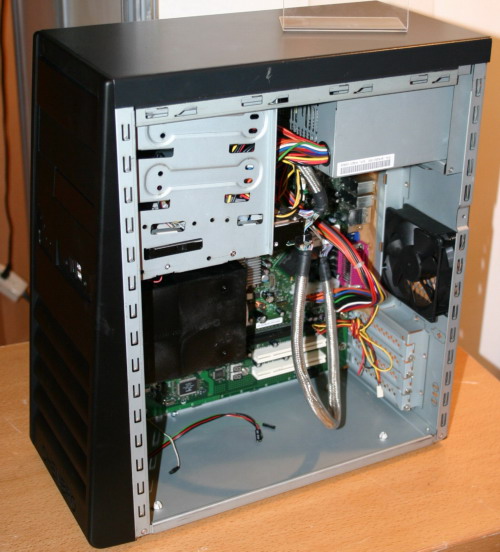
Click to Enlarge
You can see the CPU's thermal module (basically an enclosed heatsink/fan unit) at the front of the case, instead of at the back where it would be on an ATX system. You can also see the repositioned slots at the bottom of the case in the picture above.
The clutter at the back of the case is significantly reduced, thanks to the repositioning of the CPU:
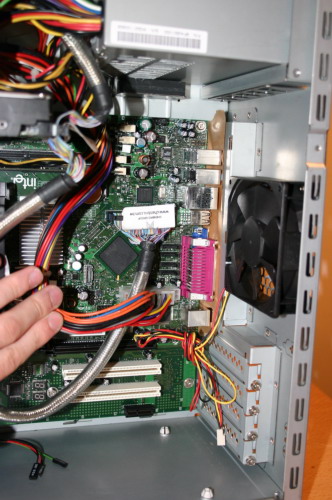
Click to Enlarge
Here's a close up of the CPU thermal module:

Apparently virtually all the case manufacturers have BTX prototype cases, but no one wants to actually produce one. Worries of extremely low sales and essentially zero initial interest make being an early manufacturing adopter far from a desirable trait.
BTX Systems
Intel's showcase also had a number of BTX cases, the most interesting of which was Shuttle's microBTX SFF:
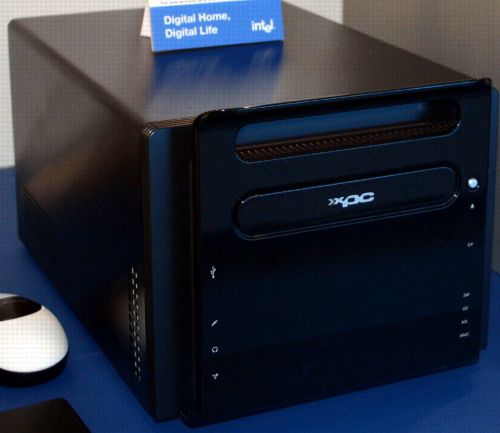
AOpen had a tower microBTX on display:

However AOpen's solution was the only tower solution present, the rest were desktops:
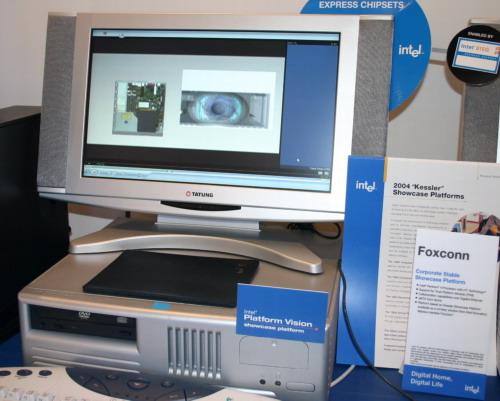
ASUS' case had a somewhat stylish front:
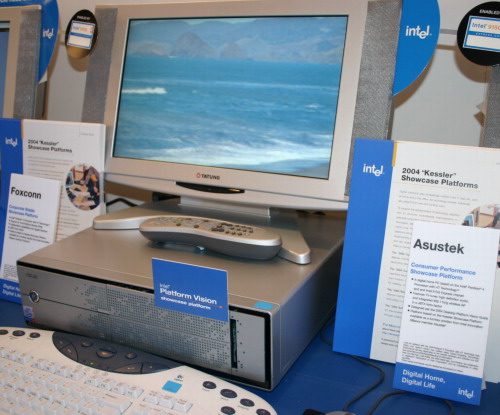

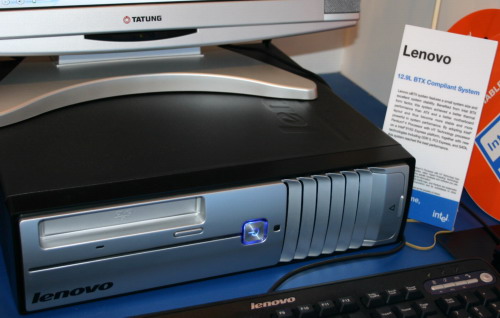
Although these aren't BTX based, Intel showed off some set top box form factor solutions running ultra low voltage P4s and i815E chipsets:
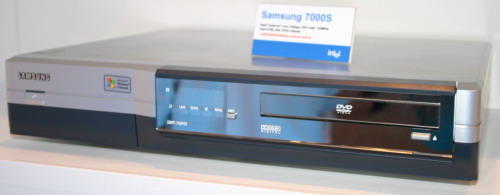
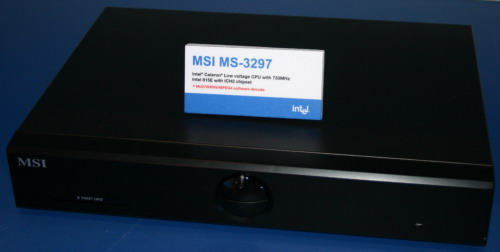
Shuttle: Better than BTX?
Although Shuttle was showing off a BTX SFF at Intel's showcase, they had their own version of the BTX standard on display in their latest SFF based on Intel's 925X chipset:
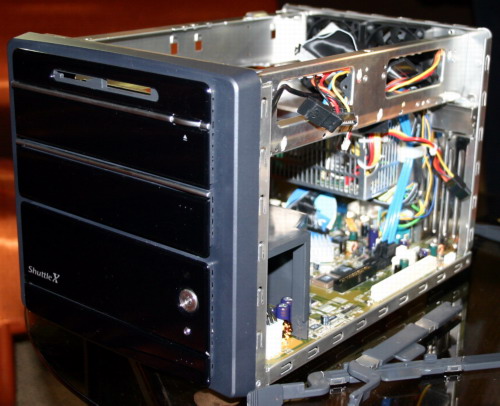
Shuttle's 925X SFF employs many BTX-like features, but others that Shuttle claims make it "better than BTX." For starters, the system has a smaller form factor than even a picoBTX based system could achieve.
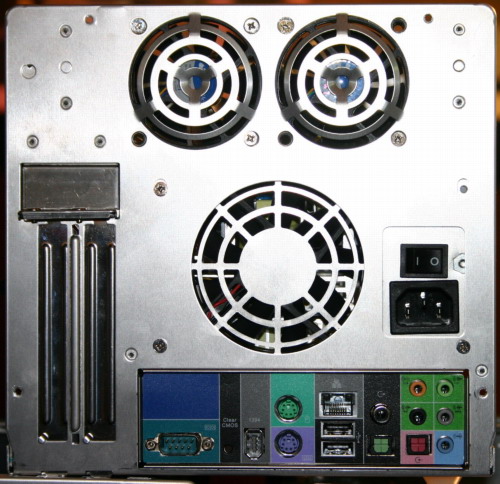
Note the three fans at the back. The larger one in the middle is for the 350W PSU, the two at the top are dedicated fans for the two hard drive bays at the top of the case.
What's also very nice is the inclusion of a clear CMOS button at the back of the case, a feature Shuttle introduced with their Zen platform:
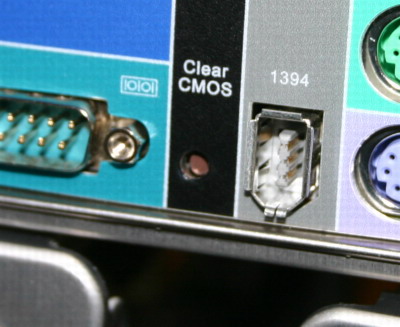
Having a clear CMOS button on the back helps avoid dealing with setting a jumper in the cramped internals (as clean as they may be on the Shuttle box).
The two connectors below are another unique feature of the 925X based SFF PC:

The connector to the left is a 4-pin fan connector (we'll get to why it's 4 pins in a bit), the connector to the right is actually a 4-pin PCI Express x1 connector - a proprietary connector that Shuttle implemented. Why include a custom PCI Express connector on the motherboard? In the event that Shuttle comes up with a unique location of a PCI Express expansion slot, run a cable to this connector and you've got instant PCI Express anywhere in the chassis. Shuttle will probably offer a cleaner connector if they decide to actually use this thing.
The PCI Express connector isn't the only unique thing about Shuttle's like-BTX box; this connector is Shuttle's version of the 4-pin 12V ATX power connector for CPUs:
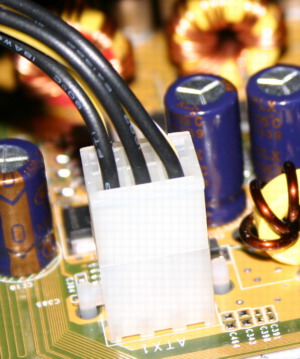
Shuttle's connector has 3 x 12V lines and 3 ground lines, and is necessary because Shuttle does not use a standard power supply connector setup for this system.
Remember the 4-pin fan header from before? Here's another pic:

What makes the 4-pin fan headers so interesting? They allow for linear fan speed control. Currently fans can only be adjusted in steps, e.g. running at 800RPM, 1500RPM or 3000RPM. The problem with this situation is that there's an abrupt increase in fan speed and thus fan noise. What these new 4-pin fan headers will allow is a linear increase in fan speed, so the fan speed and noise increases are much more gradual. Unfortunately the fan controllers that will enable this linear functionality are not yet ready and they won't be for another quarter or so.
Taking a page from the BTX spec, Shuttle's 925X system has a thermal module that is used to cool the CPU. We've taken the cover off of the front of the module for better visibility:

Here's where Shuttle's solution differs from BTX; the BTX spec calls for cool air to be brought in from the front of the case to cool the CPU, then flow over the chipset and finally by the GPU before exiting the system. Shuttle rotated the thermal module so that it pulls in cool air from the sides and exhausts it out the opposite side. The downside is that the chipset doesn't get any cool air running over it, but the benefit is that it will reduce the ambient temperature of the case.
Although you still open the chassis using thumbscrews, Shuttle has moved to a screw-less design for the hard drives:

The top of the chassis is big enough to hold two drives, and is wired for SATA power/data cables already; the idea is to use the top bays for RAID, cooled by the two fans we saw earlier. The two plastic rails you see in the picture above snap into either side of a hard drive, then snap into place on the chassis itself. The installation process is quite simple.
Shuttle also had a 915 SFF on display, although this one used their current modified ATX form factor:
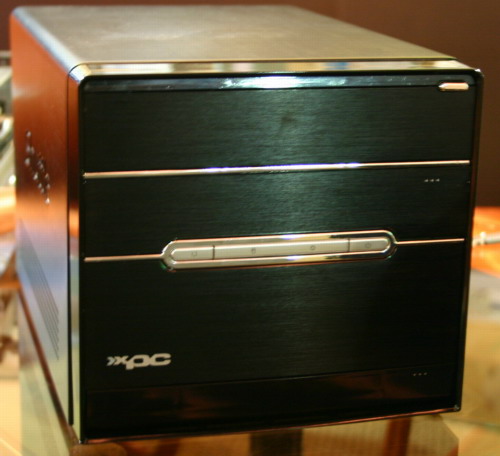
The brushed black aluminum front panel was a bit more classy than the shiny black face of the 925X unit.
The SFF itself uses a 90mm fan to keep those Prescotts cool. You can see the fan compared to the older 80mm unit below:
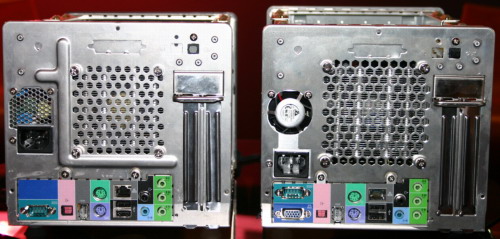
Larger fans: Shuttle's 915 system (right) employs a larger 90mm fan as you can see above
In order to keep Prescott cool Shuttle also significantly improved the efficiency of their heatpipe cooler:

The unit you see here is even more efficient than the one in the 925X platform, it's most likely the highest efficiency heatpipe that Shuttle will ever build without changing designs.
Here's a better look at the larger fan:
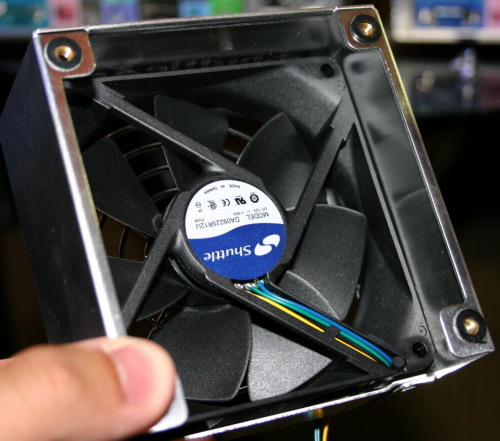
As we've mentioned before, the new LGA-775 socket is extremely fragile with uneven installation pressure being a major cause of bent pins or premature socket failure. As such, Shuttle has moved back to a spring-loaded screw installation for the heatsink similar to what they had to do for their Athlon XP SFFs.
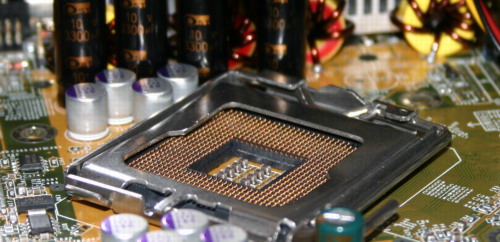
Finally the new 915 SFF also has a clear CMOS button at the rear of the case, this time not as well labeled as on the 925X platform:

Final Words
We got a number of requests for more BTX information, we hope this was what you were looking for. For us, it's back to the show - make sure you read our previous Computex coverage as well:
Computex 2004 Early Bird Coverage: NV45 in the Flesh, New Chipsets, BTX boards and more...
Computex 2004: More NV45 Information
Computex 2004: NV45 Mystery Solved

